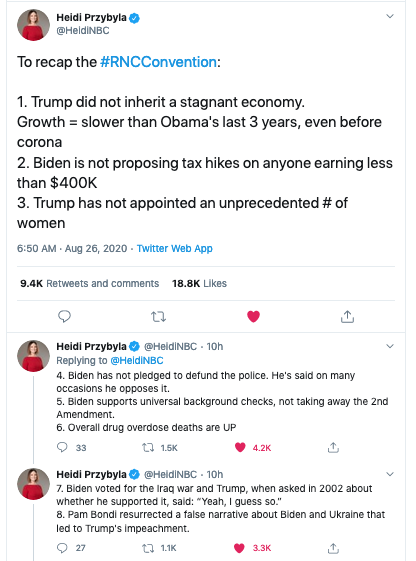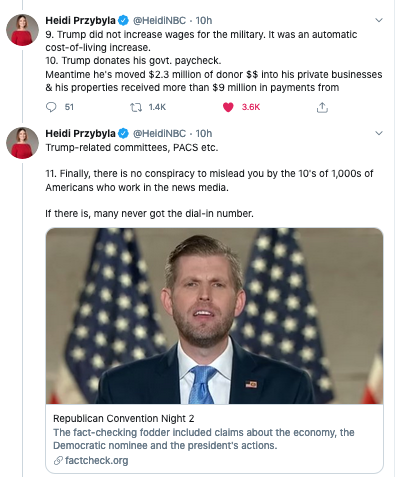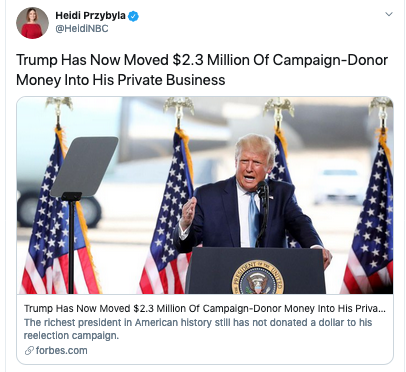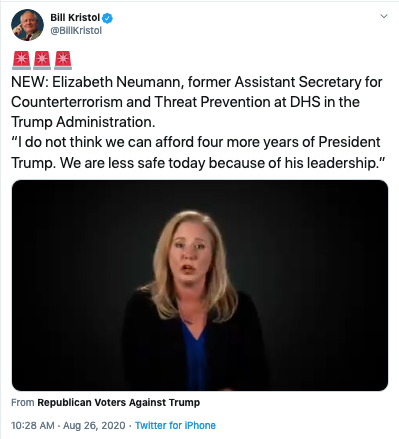https://www.youtube.com/watch?v=VIfR3yuW30Q&bpctr=1598363670
Not only is Trump’s approval with Republicans not 96 percent, energy appears to be slipping
So here’s this again.

That’s from late Tuesday night, but President Trump has made the same claim repeatedly. He said his approval among Republicans was 96 percent on June 8, on June 6, on May 21, on May 12, on May 2, on April 21 and on April 10, which was the first time he claimed his approval was 96 percent. For about a year prior, he had consistently claimed it was 95 percent. Before that, he kept saying it was 94 percent.
As we’ve repeatedly pointed out, this isn’t how approval ratings work. You don’t earn a new level and stay at that level for months on end. If Trump’s approval rating was at 94 percent over and over in 2018, it would probably have jumped to 96 percent once or twice if only because of margins of error — and he would have tweeted about it.
But it’s also obviously false because there’s no public poll showing anything similar. In fact, despite Trump’s claim that 24 out of 25 Republicans view his job performance with approval, recent polling suggests energy within his party for his performance as president might actually be slipping.
The Economist conducts a national poll each week in partnership with YouGov. Each week, it asks respondents both whether they approve of the job that Trump is doing and whether they view Trump favorably as an individual.
For the most part, those views are static: Fewer than half of Americans view Trump with approval, but most Republicans do. The same pattern holds for favorability.
We’ve added a line to mark a 96 percent approval level. If you squint, you might notice that the Republican line falls somewhat short of that level. Every week. Over and over.
There’s a lot of noise in those lines because, well, that’s how real polls work. If we take a monthly average, we get a better sense of how views about Trump have shifted.
In March, 65 percent of Republicans viewed Trump’s job performance with strong approval. In June, that dropped to 57 percent, a decline of eight points. The percentage of Republicans who said they somewhat approved of Trump’s performance increased by about four points, meaning a four-point decline overall.
That overall change isn’t significant. But this decline in enthusiasm, measured in the shift from strong to somewhat approval, is a trend that Trump would want to avoid.
That’s not because he’s at serious risk of losing Republican votes to former vice president Joe Biden. In 2016, Hillary Clinton’s campaign invested heavily in trying to appeal to Republicans frustrated with or concerned about Trump’s candidacy, pitching them on backing her as the safe choice. On Election Day, they largely didn’t. Trump earned about as much support from Republicans as preceding Republican candidates.
A similar effort is underway to woo Republicans from Trump to Biden. On Tuesday, Axios reported on a new political action committee aimed at persuading Republicans to back the Democrat. It joins other efforts, including Republican Voters Against Trump, which has been producing ads attacking the president.
There’s no indication these efforts will result in a surge in votes for Biden. After all, although Trump’s approval rating among fellow Republicans isn’t 96 percent, it is high. Getting a Republican who’s lukewarm on Trump’s presidency to completely flip to the Democrats is a near-stratospheric bar to hurdle.
But what these efforts might instead be aiming for is something more modest: getting Republicans to stay home. Suppressing support for Trump, which benefits Biden nearly as much.
We tend to think of elections as polar, voters supporting Candidate A or Candidate B. We usually forget that there’s a middle point between those two: indifference. When politicians start to see their approval ratings sag, for example, it’s not because voters go from “approve” to “disapprove” overnight. It’s because they go from “strong approve” to “somewhat approve” to “not sure” — which is often where they land permanently.
Something similar happens on Election Day. The alternative to voting for Candidate A isn’t necessarily Candidate B. It can be no candidate at all.
This is why that trend in the Economist-YouGov poll should be alarming to Trump. Seeing people grow more skeptical of his presidency could mean an increase in people deciding against bothering to vote. That’s not a two-vote swing to Biden (Trump loses a vote, and Biden gains one), but it is a one-vote swing against the incumbent. And given Trump’s reelection strategy depends on maximizing his base and tamping down support for his opponent, it’s a potentially worrisome trend.
Of course, this is also a bit of cherry-picking on its own. The overall trend for Trump’s approval has been that it hasn’t really changed much at all. We put a lot of emphasis on small movements up and down just because any movement is unusual. If the past three years hold, Trump will be viewed in November about as he is now.
Although that is still more negatively than he claims he’s viewed.

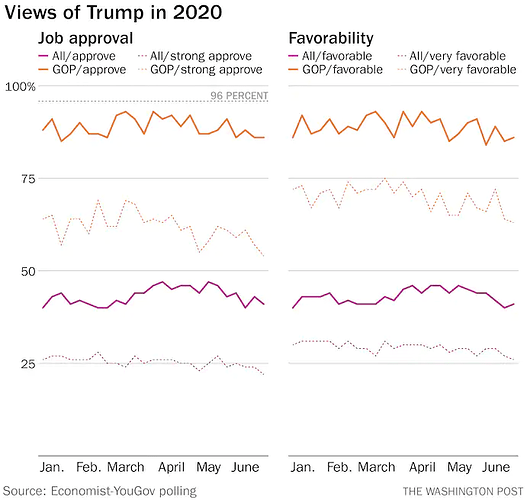
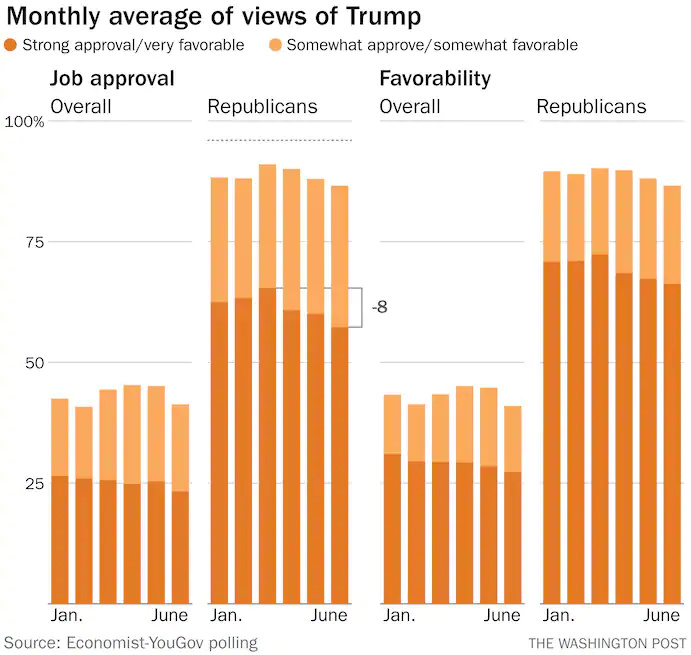
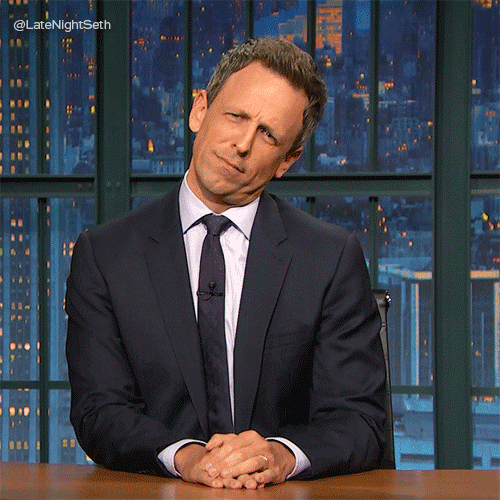

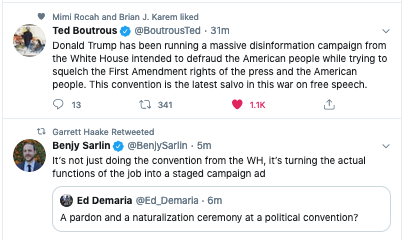





 )
)